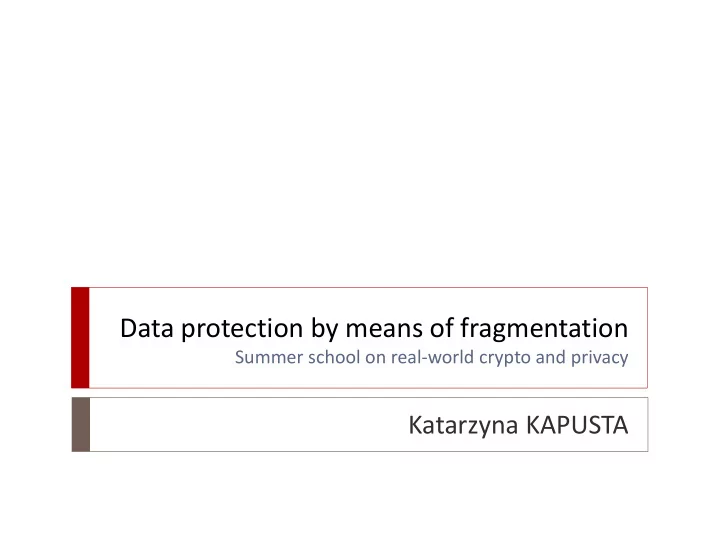

Data protection by means of fragmentation Summer school on real-world crypto and privacy Katarzyna KAPUSTA
Self introduction PhD Student at Telecom ParisTech Universite Paris-Saclay Supervisor: Gerard MEMMI Subject: data fragmentation and dispersal as a way of data protection Education and previous experience: M.Eng. Telecom ParisTech Universite Paris-Saclay, Paris, France M.Sc. AGH University of Science and Technology, Cracow, Poland Previous work experience : Security consultant, E&Y, Paris Software developer at Thales Communications & Security, Paris Software developer intern at CERN, Geneva
Why do we need fragmentation? The security of encrypted data depends on the chosen algorithm, as well as on the strength and the secure storage of its key Fragmenting data into multiple fragments and dispersing these fragments over various locations aims at frustrating an attacker Nowadays, fragmentation is enabled by the cloud environment (large number of servers, multiple data centers) and already used for data resilience purposes (RAID, Hadoop)
Our division of data fragmentation Bitwise : fragmenting data without any consideration for their structure, their semantics, or their uneven level of confidentiality - Techniques: perfect or computational secret sharing, information dispersal algorithms Structurewise : exploiting data structures, multi-level confidentiality, and machine trustworthiness - Techniques: database fragmentation, selective encryption
Fragmentation in the cloud: issues Physical location control vs. virtualization How to ensure secure data separation? Bare-metal cloud? Special agreement? Hybrid cloud? Coarse-grained solution: multi-cloud Latency problems: combining fragmentation with parallelization Defining security levels without user interaction for fragmentation of structured data
Fragmentation in the cloud: desired architectural traits
Improving information dispersal • Information Dispersal Algorithms (IDAs): a space-efficient keyless way to fragment and add resilience to data at the same time • Used mostly in transmission scenarios • Problem : lack of data protection, patterns are preserved inside the fragments • Solution : a dispersal scheme that keeps the main properties of the IDAs while improving data protection (and also performance) Original IDA Our algorithm
Improving information dispersal Performance comparison with relevant works in an IoT scenario 120 Our proposal 100 IDA AONT-RS / RC4 + MD5 80 AONT-RS / AES-128 + SHA-256 MB/s Shamir Secret Sharing 60 40 20 0 2 3 4 5 6 7 8 9 10 11 12 13 14 15 16 17 18 19 20 Number of fragments needed for data recovery (K)
References: K. Kapusta, G. Memmi, and H.Noura , ”POSTER: A Keyless Efficient Algorithm for Data Protection by Means of Fragmentation”, in ACM CCS 2016, Vienna, 2016 . K. Kapusta and G. Memmi, ”Data protection by means of fragmentation in several distributed storage systems ”, in CFIP - Notere, Paris, 2015. G. Memmi, K.Kapusta, and H.Qiu , ”Data protection by means of fragmentation in several distributed storage systems ”, in Cyber Security of Smart Cities, Industrial Control System and Communications (SSIC), 2015 G. Memmi, K.Kapusta, and H.Qiu , ”Data Protection: Combining Fragmentation, Encryption, and Dispersion, an intermediary report”, ITEA2 -CAP WP3 Intermediary Report, June 2015.
Thank you!
Recommend
More recommend